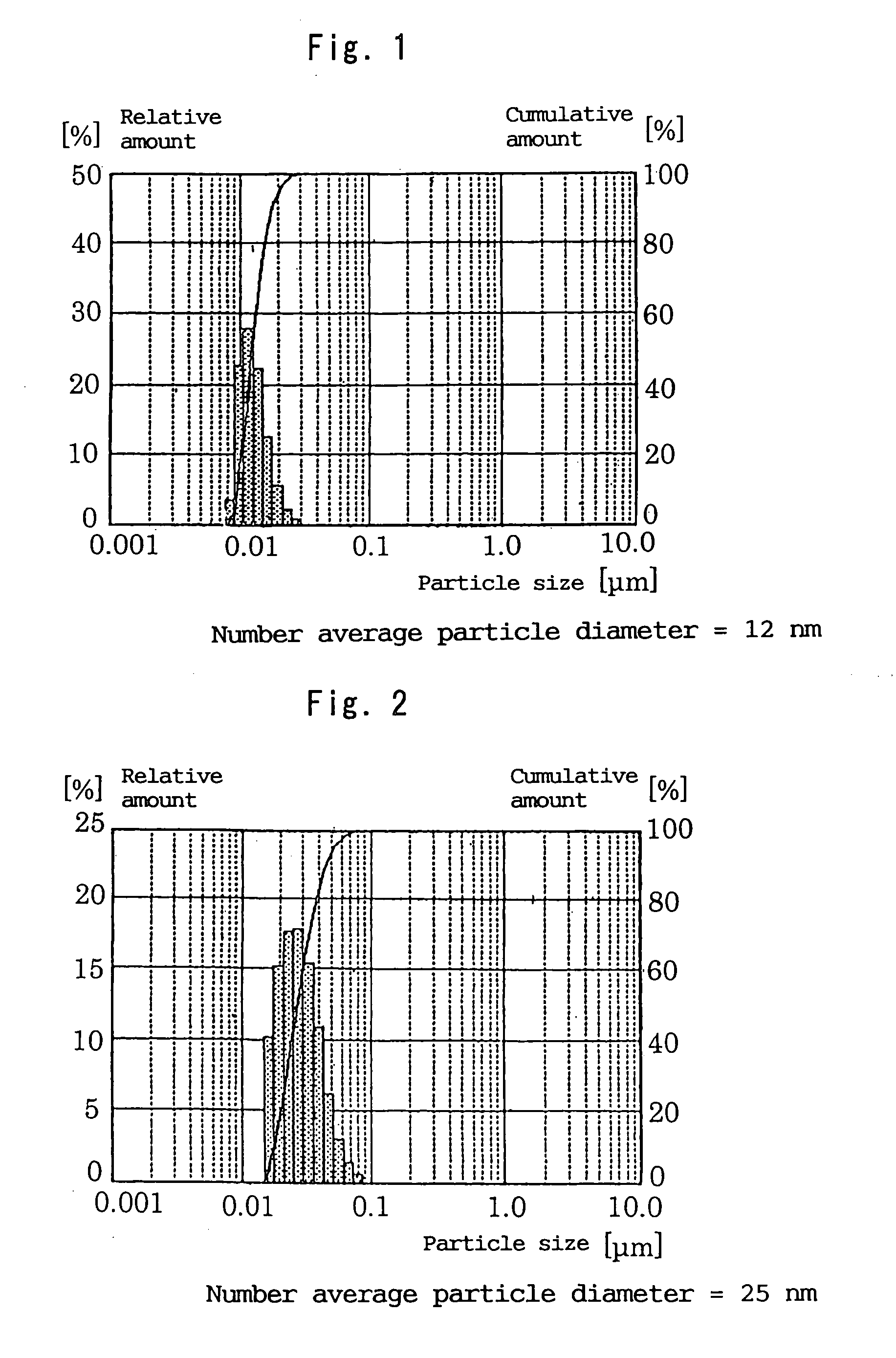Photocatalyst composition
a technology of composition and photocatalyst, which is applied in the direction of organic compound/hydride/coordination complex catalyst, physical/chemical process catalyst, metal/metal-oxide/metal-hydroxide catalyst, etc., can solve the problem of difficult immobilization of photocatalyst, calcination, and inability to allow the photocatalyst to exhibit its effect on the surface of the substrate, etc. problem, to achieve the effect of excellent durability and excellent hard balan
- Summary
- Abstract
- Description
- Claims
- Application Information
AI Technical Summary
Benefits of technology
Problems solved by technology
Method used
Image
Examples
reference example 1
[0333]Synthesis of Phenyl Group-Containing Silicone (BP1-1)
[0334]78 g of dioxane was charged into a reactor equipped with a reflux condenser, a thermometer and a stirrer, and 26.0 g of phenyltrichlorosilane was added thereto, followed by stirring at room temperature for about 10 minutes. To the resultant mixture was dropwise added a mixture of 3.2 g of water and 12.9 g of dioxane over about 30 minutes while maintaining the internal temperature of the reactor at 10 to 15° C., followed by stirring at 10 to 15° C. for about 30 minutes and, then, at 60° C. for 3 hours, thereby obtaining a first reaction mixture. The obtained reaction mixture was cooled to 25 to 30° C. and 392 g of toluene was dropwise added to the cooled reaction mixture over about 30 minutes. Subsequently, the temperature of the resultant mixture was elevated to 60° C., followed by further stirring for 2 hours at 60° C., thereby obtaining a second reaction mixture.
[0335]The second reaction mixture was cooled to 10 to 1...
reference example 2
[0337]Synthesis of Alkyl Group-Containing Silicone (BA-1)
[0338]300 g of methanol was charged into a reactor equipped with a reflux condenser, a thermometer and a stirrer, and 136 g (1 mole) of methyltrimethoxysilane and 120 g (1 mole) of dimethyldimethoxysilane were added thereto, followed by stirring at room temperature for about 10 minutes. To the resultant mixture was dropwise added a mixture of 12.6 g (0.7 mole) of a 0.05N aqueous hydrochloric acid solution and 63 g of methanol over about 40 minutes while cooling the reactor with ice, thereby effecting a hydrolysis reaction. Subsequently, the resultant mixture was further stirred at 10° C. or less for about 20 minutes and, then, at room temperature for 6 hours, thereby obtaining a reaction mixture.
[0339]The obtained reaction mixture was subjected to reduced pressure distillation at 60° C. to distill off the solvents from the reaction mixture, thereby obtaining an alkyl group-containing silicone (BA-1) having a weight average mol...
reference example 3
[0341]Synthesis of Alkyl Group-Containing Silicone (BA-2)
[0342]470 g of dioxane was charged into a reactor equipped with a reflux condenser, a thermometer and a stirrer, and 25.8 g of methyltrichlorosilane was added thereto, followed by stirring at room temperature for about 10 minutes. To the resultant mixture was dropwise added a mixture of 4.7 g of water and 18.7 g of dioxane over about 30 minutes while maintaining the internal temperature of the reactor at 10 to 15° C., followed by stirring at 10 to 15° C. for about 30 minutes and, then, at 60° C. for 3 hours, thereby obtaining a reaction mixture.
[0343]The obtained reaction mixture was cooled to 10 to 15° C., followed by addition of 30.2 g of methanol over about 30 minutes. The resultant mixture was further stirred at 25 to 30° C. for about 2 hours and, then, the temperature of the resultant mixture was elevated to 60° C., followed by further stirring for 3 hours, thereby completing the reaction. The resultant reaction mixture w...
PUM
| Property | Measurement | Unit |
|---|---|---|
| number average particle diameter | aaaaa | aaaaa |
| primary particle diameter | aaaaa | aaaaa |
| primary particle diameter | aaaaa | aaaaa |
Abstract
Description
Claims
Application Information
 Login to View More
Login to View More - R&D
- Intellectual Property
- Life Sciences
- Materials
- Tech Scout
- Unparalleled Data Quality
- Higher Quality Content
- 60% Fewer Hallucinations
Browse by: Latest US Patents, China's latest patents, Technical Efficacy Thesaurus, Application Domain, Technology Topic, Popular Technical Reports.
© 2025 PatSnap. All rights reserved.Legal|Privacy policy|Modern Slavery Act Transparency Statement|Sitemap|About US| Contact US: help@patsnap.com



